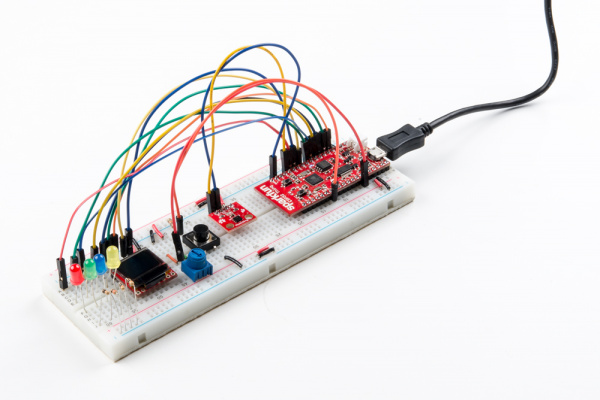ESP32 Thing Hookup Guide - cchamchi/ESP32 GitHub Wiki
Introduction
SparkFun ESP32는 인기를 끌어던 ESP8266의 Super-charged 버전인 Espressif’s ESP32를 위한 종합적인 개발 플랫폼이다. ESP8266과 같이, ESP32는 WiFi호환 마이크로 컨트롤러에 추가적으로 블루투스 저에너지(예:BLE, BT4.0)를 지원하고 SmartI/O 핀이 30개나 지원된다. ES32의 강력한 기능과 다재 다능함은 앞으로 여러 해 동안 IoT기반을 구축하고 IoT와 연결된 프로젝트를 만드는 데 도움을 줄것입니다.

SparkFun ESP32 Things 는 ESP32를 포함하여 프로그래밍, 실행 및 개발에 필요한 모든 것을 제공하고 있습니다. WiFi/BLE SoC외에도 FTDIFT232x1x가 포함되어 있어 USB를 직렬로 변환하고 컴퓨터에서 마이크로 컨트롤러를 프로그래밍하고 통신할 수 있습니다. 또한 리튬 폴리머 배터리 충전기를 갖추고 있으므로, ESP32프로젝트는 진정 무선일 수 있습니다. 또한 보드에는 개발에 도움이 되는 몇개의 LED와 버튼이 포함되어 있습니다.
Hardware Overview
Espressif’s ESP32 is one of the most unique microcontrollers on the market. Its laundry list of features include:
- Dual-core Tensilica LX6 microprocessor
- Up to 240MHz clock frequency
- 520kB internal SRAM
- Integrated 802.11 BGN WiFi transceiver
- Integrated dual-mode Bluetooth (classic and BLE)
- 2.2 to 3.6V operating range
- 2.5 µA deep sleep current
- 32 GPIO
- 10-electrode capacitive touch support
- Hardware accelerated encryption (AES, SHA2, ECC, RSA-4096) The ESP32 Thing is designed to surround the ESP32 with everything necessary to run and program the microcontroller, plus a few extra goodies to take advantage of the chip’s unique features.

Peripherals and I/O
The ESP32 features your standard fare of hardware peripherals, including:
- 18 analog-to-digital converter (ADC) channels
- 3 SPI interfaces
- 3 UART interfaces
- Two I2C interfaces
- 16 PWM outputs
- 2 digital-to-analog converters (DAC)
- Two I2S interfaces And, thanks to the chip’s pin multiplexing feature, those peripherals can be connected to just about any of the 28 broken out I/O pins. That means you decide which pins are RX, TX, MISO, MOSI, SCLK, SDA, SCL, etc.
There are, however, a few hardware features – namely the ADC and DAC – which are assigned static pins. The graphical reference below helps demonstrate where you can find those peripherals (click to embiggen!).

One I2C, two of the UART interfaces, and one of the SPI interfaces can be assigned to any pin your project requires.
Input Only Pins: 34-39
Pins 34, 35, 36, 37, 38 and 39 cannot be configured as outputs, but they can be used as either digital inputs,
analog inputs, or for other unique purposes. Also note that they do not have internal pull-up or pull-down
resistors, like the other I/O pins.
GPIO pins 36-39 are an integral part of the ultra low noise pre-amplifier for the ADC – they are wired up to
270pF capacitors, which help to configure the sampling time and noise of the pre-amp.
Schematic close up of pins 34-39

From the ESP32 Thing Schematic: GPIO 36-39 are tied together with caps. Those and pins 34 and 35 are input only!
Powering the ESP32 Thing
ESP32 Things에 대한 두가지 주요 전력 입력은 USB와 단일 셀 리튬 폴리머 배터리입니다. USB와 Lipo가 보드에 모두 연결되어 있는 경우에는 내장형 충전 컨트롤러가 최대 500mA의 속도로 Lipo배터리를 충전합니다.
The ESP32's operating voltage range is 2.2 to 3.6V. Under normal operation the ESP32 Thing will power the chip
at 3.3V. The I/O pins are not 5V-tolerant! If you interface the board with 5V (or higher) components, you'll
need to do some level shifting.
The 3.3V regulator on the ESP32 Thing can reliably supply up to 600mA, which should be more than enough overhead for most projects. The ESP32 can pull as much as 250mA during RF transmissions, but we’ve generally measured it to consume around 150mA – even while actively transmitting over WiFi. The output of the regulator is also broken out to the sides of the board – the pins labeled “3V3.” These pins can be used to supply external components.

In addition to USB and battery connectors, the VBAT, and VUSB pins are all broken out to both sides of the board. These pins can be used as an alternative supply input to the Thing. The maximum, allowable voltage input to VUSB is 6V, and VBAT should not be connected to anything other than a LiPo battery. Alternatively, if you have a regulated voltage source between 2.2V and 3.6V, the “3V3” lines can be used to directly supply the ESP32 and its peripherals.
Assembly Tips
The ESP32 Thing ships without anything soldered into the header pins – ensuring that you can mold the board to best fit your project. To use the chip’s pins you’ll need to solder something to the I/O and power rail vias broken out to either side of the board.
What you solder to the ESP32 Thing’s I/O pins is completely up to you. The header rows are breadboard-compatible, so you may want to solder male headers in. (Mildly satisfying: the ESP32 Thing’s pair of 20-pin headers means you can get the most out of our 40-pin header strips.)

